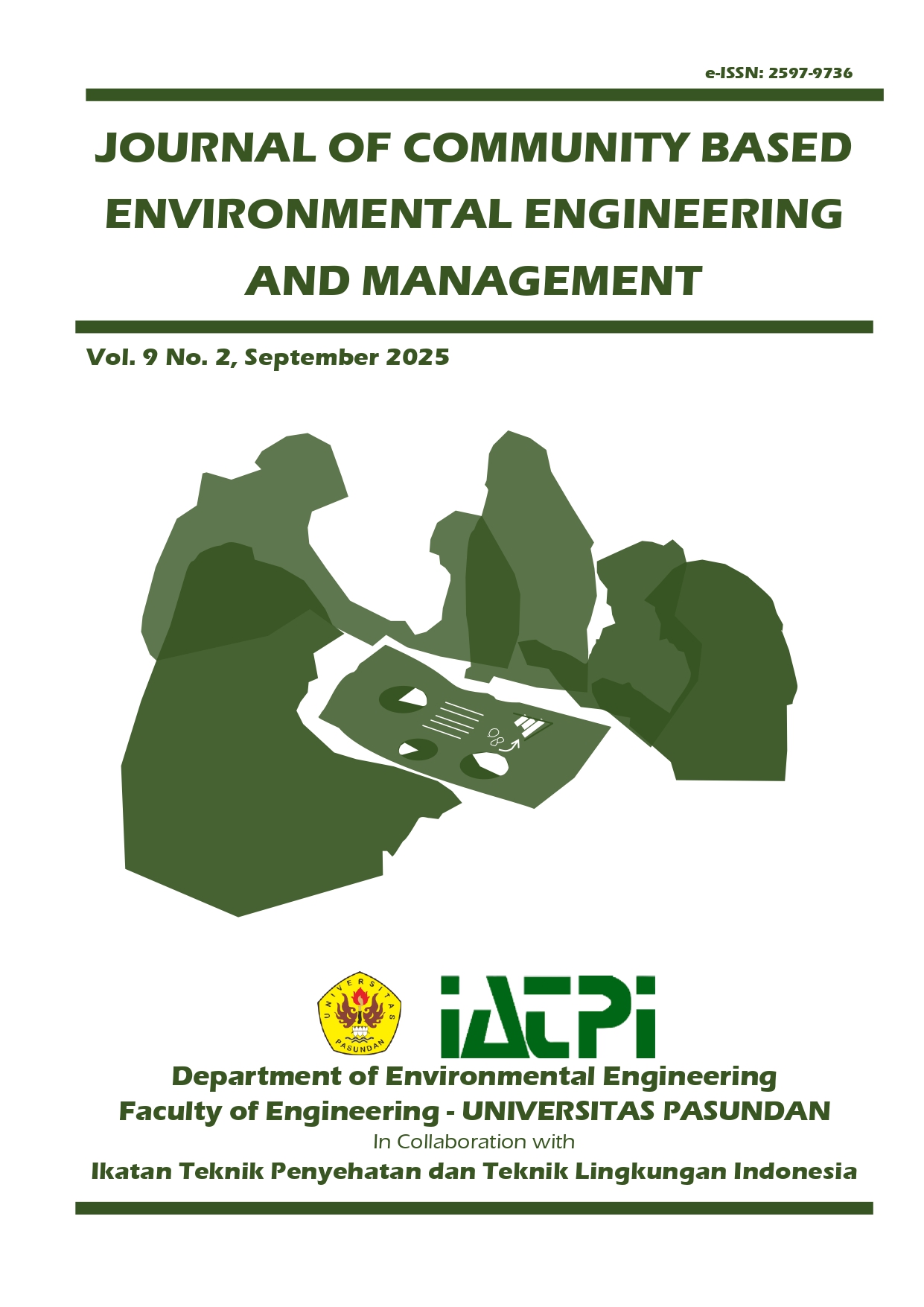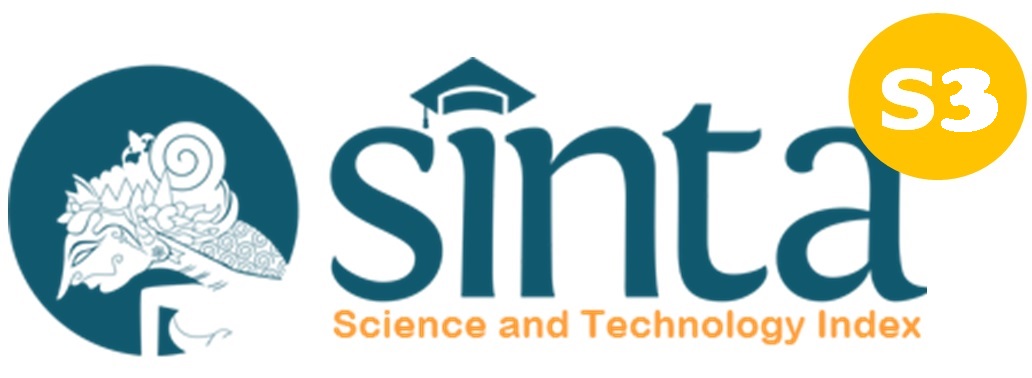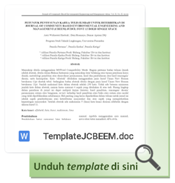The Effectiveness of the Electrocoagulation Process in Reducing TDS Concentration in Brackish Water in Subang Regency
DOI:
https://doi.org/10.23969/jcbeem.v9i2.32579Keywords:
aluminum electrode, electrocoagulation, brackish water, TDSAbstract
Brackish water is a water resource that has the potential to be used as raw water, but has limitations due to high levels of total dissolved solids (TDS) This study aims to analyze the effectiveness of the electrocoagulation method in reducing these pollutant parameters in brackish water samples from Subang Regency. The groundwater samples were taken in the area of the Diniyah Takmiliyah Awaliyah Islamic Madrasa School. The research was conducted using a prototype electrocoagulation device with a pair of aluminum plates, varying voltages (10, 12, 14, and 15 volts), varying flow rates (0.06 L/second and 0.08 L/second), and conditions with and without a plate settler in the sedimentation unit. The results showed that increasing the voltage significantly reduced TDS levels. The highest efficiency was achieved at 10 volts with a flow rate of 0.06 L/second, reducing TDS from 3,400 mg/L to 3,110 mg/L (8.5%). Meanwhile, the lowest efficiency was achieved at 12 volts with a flow rate of 0.08 L/second, at 2.1%. Overall, this study confirms that electrocoagulation can be an alternative brackish water treatment technology in coastal areas. Although the TDS reduction efficiency is still limited, this method can be further developed as part of an integrated system to support sustainable clean water availability.
Downloads
References
APHA. (2017). Standard Methods for the Examination of Water and Wastewater. 23rd ed. American Public Health Association.
Afiatun, E., Pradiko, H., & Fabian, E. (2019). Turbidity Reduction for the Development of Pilot Scale Electrocoagulation Devices. International Journal of Geomate, 16(56), 123-128.
Brinda, Divyashree, M.S., Rao, S.A., Rao, P., & Mulky, L. (2025). Microbiologically influenced corrosion in aluminium alloys and premier techniques for comprehensive identification and characterization across diverse metal types. Journal of Chemical Technology and Biotechnology, 100, 1143-1158.
Danial, M.D., Soeryamassoeka, S.B., Irmansyah, F., Purnaini, R., & Teguh, R. (2024). Electrocoagulation and Filtration for Brackish Peat Water Desalination. Jurnal Teknik Sipil, 24(4), 1460-1467.
Emamjomeh, M. M., & Sivakumar, M. (2009). Review of pollutants removed by electrocoagulation and electrocoagulation/flotation processes. Journal of Environmental Management, 90(5), 1663–1679. https://doi.org/10.1016/j.jenvman.2008.12.011
Golder, A. K., Samanta, A. N., & Ray, S. (2007). Removal of trivalent chromium by electrocoagulation. Separation and Purification Technology, 53(1), 33–41. https://doi.org/10.1016/j.seppur.2006.06.015
Hermawan, S., Apriyanto, F., Limantara, I.R., Steven, D., Fernaldi, J., & Prajogo, J.E. (2023). A practical implementation of brackish water treatment with local material in Sidoarjo Regency, East Java, Indonesia. Civil Engineering Dimension, 25(1), 53-66.
Holt, P. K., Barton, G. W., Wark, M., & Mitchell, C. A. (2002). A quantitative comparison between chemical dosing and electrocoagulation. Colloids and Surfaces A: Physicochemical and Engineering Aspects, 211(2-3), 233–248. https://doi.org/10.1016/S0927-7757(02)00285-6
Jebur, M., Chiao, Y.H., Matsuyama, H., & Wickramasinghe, R. (2024). Electrocoagulation as a pretreatment for reverse osmosis for potable water from brackish groundwater. Water Resources and Industry, 31, 100243
Kobya, M., Can, O. T., & Bayramoglu, M. (2003). Treatment of textile wastewaters by electrocoagulation using iron and aluminum electrodes. Journal of Hazardous Materials, 100(1-3), 163–178. https://doi.org/10.1016/S0304-3894(03)00102-X
Kobya, M., Hiz, H., Senturk, E., Aydiner, C., & Demirbas, E. (2006). Treatment of potato chips manufacturing wastewater by electrocoagulation. Desalination, 190(1-3), 201–211. https://doi.org/10.1016/j.desal.2005.10.006
Kusumartono, F. X., & Rizal, M. (2019). An integrated assessment of vulnerability to water scarcity measurement in small islands of Indonesia. Natural Science, 24(4), 117-133.
Mânez, K. S., Husain, S., Ferse, S. C. A., & Costa, M.M. (2012). Water scarcity in the Spermonde Archipelago, Sulawesi, Indonesia: Past, present and future. Environmental Science & Policy, 36, 74–84.
Masduqi, A., Nugroho, A.R., & Wilujeng, S.A. (2020). Solution to water scarcity in the eastern Indonesia: A case of Lembata Regency. International Journal of GEOMATE, 19(71), 69-76.
Mollah, M. Y. A., Schennach, R., Parga, J. R., & Cocke, D. L. (2001). Electrocoagulation (EC)—science and applications. Journal of Hazardous Materials, 84(1), 29–41. https://doi.org/10.1016/S0304-3894(01)00176-5
Mustapha, B. (2025). Evaluation on Electrocoagulation Effectiveness for Lead Removal in Lead Refining Effluent. Asian Journal of Green Chemistry, 9, 775-793.
Pradiko, H., Afiatun, E., & Fabian, E. (2018). Influence of Mixing and Detention Time in Electro Coagulation Process to Treat Raw Water at Badak Singa Water Treatment Plant. Indonesian Journal of Urban and Environmental Technology, 1(2), 137-150.
Raharini, H., Razak, A., & Diliarosta, S. (2025). The relationship between sea water intrusion and fresh water availability in the Provision of Clean Water Sources in Padang Pariaman Regency West Sumatra Province. Amplitudo, 4(1), 48-52.
Rusdianasari, R., Hajar, I., & Ariyanti, I. (2020). Electrocoagulation Method to Reduce Pollutants in the Wastewater of Jumputan Fabric Industri. Indonesian Journal of Fundamental and Applied Chemistry, 5(3), 71-77.
Salam, M., Purnama, R.K., & Latifah, B. (2022). Study of Fe, Ca, and Mg removal using electrocoagulation method from wastewater integrated canal. IOP Conf. Series: Earth and Environmental Science, 1017, 012025.
Tayeh, Y.A. (2024). A comprehensive review of reverse osmosis desalination: Technology, water sources, membrane processes, fouling, and cleaning. Desalination and Water Treatment, 320, 100882.
Un, U. T., Aytac, E., & Koparal, A. S. (2013). Electrocoagulation in a packed bed reactor-combination of electrocoagulation and filtration. Separation and Purification Technology, 107, 108–115. https://doi.org/10.1016/j.seppur.2013.01.018
Vik, E. A., Carlson, D. A., Eikum, A. S., & Gjessing, E. T. (1984). Electrocoagulation of potable water. Water Research, 18(11), 1355–1360. https://doi.org/10.1016/0043-1354(84)90003-4














